2 important questions for better problem-solving

Effective problem-solving requires that we ask better questions. However, two of the most important questions – “What if?” and “Says who?” – require courage. Because if you ask them on a regular basis, you’re challenging your farm’s history, traditions and the status quo.
1. What if?
This question exposes holes in our plans and highlights the importance of crafting contingencies.
Economist Danny Klinefelter says every plan should have a backup plan, and every entry strategy should have an exit strategy. “Top guys always spend their time before they spend their money. The real difference between the best and the rest of the herd doesn’t lie just in planning, but in contingency planning.”
Asking “what if?” creates possibility thinking, which leads to innovation.
But contingency planning is only useful if we’re willing to see our situation in the harsh light of reality.
When you know of some potentially dangerous situation that can mess up your Plan A, you’d better consider a Plan B. Even if we test our plans, we tend to limit ourselves to most likely outcomes and not consider those dragon issues that may be a very large and real problem.
Asking the right questions
As you enter into any new venture, it’s worth taking the time to consider realistic what-ifs and worst-case scenarios. I heard one lender refer to this process as shock-testing. It’s really the basis of risk management.
Klinefelter says the most frequent error he sees is when farmers believe they’re addressing the issue of alternative outcomes, but they’re evaluating the impact of standard scenarios, such as a 10 or 25% decrease in revenues.
While it’s not great to dwell on the negative, it’s crucial to consider what could go wrong and your options if it does. Transition planning, successor development, buy-sell agreements and various types of insurance are examples of ways to ensure you ask yourself realistic what-if questions.
Ask yourself:
What if we have a major production drop or disease outbreak?
What if there’s a death, divorce, disability or a decision by one of the owners to leave the business?
What if input prices double or commodity prices fall by 50%?
What if we lose a contract or land lease?
Seeing possibilities
“What if?�” can be useful to a business in a completely different way. It could be argued that any discovery or innovation begins with someone asking, “What if?” Netflix was started when someone asked the disruptive question, “What if a video rental company didn’t charge late fees?”
If you’re a leader in your farm business, here’s a challenge for you:
Consider running some of your daily or annual routines through a what-if audit. Then ask your staff to do the same thing. Why? The majority of us are simply not objective. Psychologists call this mental road bump a “confirmation bias.”
The Wall Street Journal reveals “a recent analysis of psychological studies with nearly 8,000 participants concluded that people are twice as likely to seek information that confirms what they already believe as they are to consider evidence that would challenge those beliefs.”
Asking “What if?” creates possibility thinking, which leads to innovation. Innovation is an important part of every farm business to ensure competitive advantage and sustainability.
It’s possible the single most important question you can ask yourself in business is “What if?” It not only forces us to create contingency plans but helps us consider new possibilities as well.
2. Says who?
A mentor once taught me that it’s healthy to always question statements. When someone proclaims, “It can’t be done,” I always ask myself, “Says who?”
In early 1954, the world record for the mile run was exactly where it had been stuck for a decade: four minutes and one second. According to History.com, breaking the four-minute barrier was largely considered impossible. “Many thought it unbreakable, and dozens of medical journals reported that it was physiologically impossible for the human body to break through the barrier.”
It’s no surprise so-called experts might reach this conclusion. When generations pass and no one reaches that mark, you might begin to believe it’s simply not possible.
In 1954, runner and medical student Roger Bannister was aware what medical experts had printed about the four-minute barrier. He essentially said to himself, “Says who?” He simply ignored them. In May 1954, Bannister became the first person in history to break the four-minute mile: three minutes, 59.6 seconds.
Bannister’s record was remarkable in another way. According to legend, it took about 1,000 years of trying for one man to break through a barrier considered to be unbreakable. By breaking the four-minute mile, Bannister removed the false ceiling that limited everyone else. The National Union of Track Statisticians reports that during the 60 years since Bannister’s remarkable feat, more than 1,300 athletes have broken the four-minute mile mark. That’s nearly one every two weeks.
Reject the status quo
Danny Klinefelter says the best competitive edge you can give yourself costs nothing at all.
Klinefelter says the best competitive advantage is to learn and adapt faster than your competition through continuous improvement and by rejecting the status quo.
I think it’s hard for us to understand just how fast our knowledge of any subject becomes outdated and irrelevant. It can be difficult to see the pace of change around us. It’s a bit like travelling in an airplane. Flying at 40,000 feet, you could look out the window and have no idea the geography below you is changing at a rate of 800 kilometres per hour.
Since the rate of change in agriculture is so quick, any management thinking that defends the status quo will quickly manage a world that no longer exists. In short, just because the choice you made for last year’s crop was a good one doesn’t mean that same decision will be a good one this year.

Jeff Vanhie always knew he wanted to farm, and this early commitment has well-positioned him and his wife Sara for future opportunities. They share advice for other young farmers who want to do the same.
